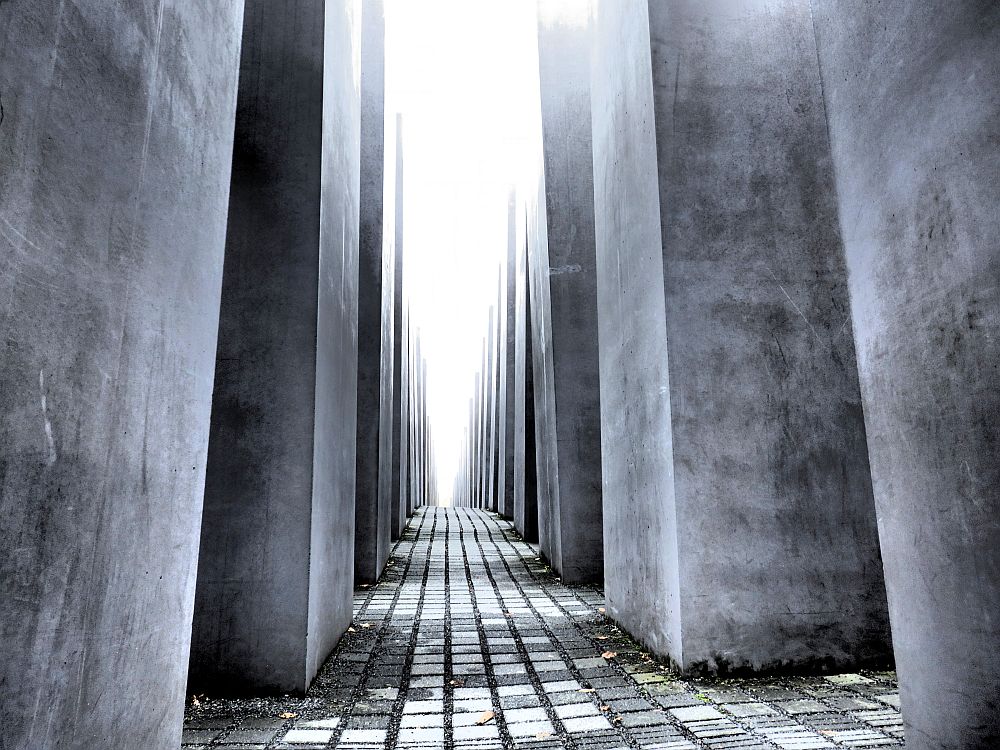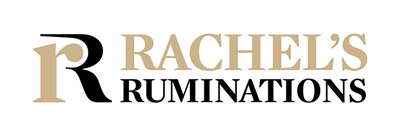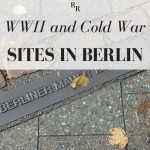WWII and Cold War sites in Berlin
Berlin is a wonderfully diverse and dynamic city, and especially intriguing to visit as a tourist with an interest in history. In particular, Berlin is the place to go if you like learning about 20th-century history, and, more specifically, World War II and the Cold War.

I’ve written about a number of Berlin’s WWII and Cold War sites separately, and I visited again recently, fitting in a few more. This article, then, is an overview, and for many of the sights you can click through to read more detail. Use the table of contents below to jump to whatever you’re most interested in.
Disclosure: This article contains affiliate links. If you click on one and make a purchase, I will receive a small commission. This will not affect your price.
Updated April 21, 2025.
WWII sites in Berlin
Berlin was and is again the capital of Germany. That means it all began and, ultimately, ended here: all the planning and plotting by the Nazi leadership, and the acquiescence and collaboration of the general population. The phrase that kept running through my mind at so many of these sites was “the banality of evil,” from Hannah Arendt’s report on Adolf Eichmann’s war crimes trial.
If you want to read more specifics about the Third Reich and wartime history of Berlin, Wikipedia gives a good overview.
In the war, Berlin was heavily bombed, so not much remains of the places used by the Nazi leadership. Nevertheless, a number of sights in Berlin that are related to World War II are worth visiting.
Berlin Story Bunker
Housed in a World War II bunker that was strong enough to withstand a direct hit from an American bomb, the Berlin Story Bunker actually contains two separate museums: “Hitler: How could it happen?” and “Germany 1945-today.” There’s also an exhibition space where the topics change from time to time.

Hitler: How could it happen?
I spent lots of time in the “Hitler: How could it happen?” exhibit. While it is organized, for the most part, chronologically, it stays consistently focused on the exhibit’s guiding question, circling back to possible explanations for Hitler’s rise to power.
Starting even before Hitler was born, this approach emphasizes the coming together of a range of causes that led to Hitler’s rise. Visitors, either viewing pictures and their explanatory texts, or listening to an audio guide while viewing the pictures, walk step-by-step through the details of Hitler’s childhood, his war experiences and his rise to power, with detours into other events that contributed.
While this may sound like the designer of the exhibit is an apologist for the rise of Nazism, I did not feel that way. I thought it was an effective way to help me try to comprehend, in particular, why so many ordinary Germans didn’t just remain passive, but actually supported this man and his whole regime. It’s a lesson many societies need to learn, if we’re going to prevent similar atrocities from happening again.
Germany 1945-today
I haven’t seen this exhibition – it was added after my visit when I first wrote this article. It follows the story further, covering post-war Berlin, Berlin in the Cold War, the fall of the Berlin Wall, and current controversies in Berlin and Germany as a whole.
These two exhibitions are very comprehensive – expect to spend at least two hours, but probably more. Make sure to get the audio guide, which is included with admission.
Berlin Story Bunker: Schönebergerstraße 23a, 5 minutes’ walk from Potsdamer Platz. Open daily 10-19:00, last admission 17:30. Admission to both parts is €12 – no cash accepted. Website.
Buy tickets here.
The Jewish Museum
This remarkable museum has two parts. Downstairs, in the three “Axes” – long, sloping corridors – visitors are confronted with a very small selection of personal objects left behind by Jews who fled Germany or who died in the Holocaust. The building itself contributes in its design to giving visitors a sense of vulnerability.

Next, visitors climb a long staircase to a more traditional museum charting the history of Jews in Germany, partly chronologically, and partly by topic. This design – creating an emotional connection first, then exploring the Jews’ history – is unusual and, in my view, very successful.
You can read more about the Jewish Museum at this link.
Judisches Museum Berlin: Lindenstraße 9-14. Open daily 10:00-18:00, last admission 17:00. Admission to the permanent exhibits is free. Temporary exhibitions are €10; free for children under 18. Website.
Memorial SA Prison Papestrasse
As early as 1933, a concentration camp run by the SA, Hitler’s earliest paramilitary group, was operated here in a former barracks. Still in their original condition, the rooms they used as cells can be viewed. Photos and documents, as well as an audio tour, explain what happened there.
Gedenkort SA-Gefängnis Papestraße : Werner-Voß-Damm 54a, S-Bahn exit General-Pape-Straße. Open Tuesday-Thursday and Saturday-Sunday 13:00-18:00. Admission: free. Website.
Topography of Terror
The Topography of Terror stands on the site where the Nazi SS headquarters once stood. Now reduced to a few ruined basement walls, the headquarters has been replaced by a stark, modern building where the focus lies on the SS and its history.

This is not an interactive museum; it consists mostly of large hanging boards dividing the history of the SS into five spaces. In chronological detail, it explains the rise of Hitler and the SS and the development of their role. It takes their story through the pre-war period, the persecution of the Jews, the development of the Final Solution, and their treatment of the citizens of the countries they invaded. It details what happened to the decision-makers after the war and the various trials and executions. It’s a grim story, told almost blandly.
Around the building is a park of sorts. It was raining, so I didn’t hang around, but it looks like it may be the more literal topography of the title. The remains of some SS structures as well as buildings that predated the SS are still visible in places. Walking by the site later, I noticed that the tree-covered land looks bumpy: I suspect this is the result of wartime bombing raids.
Topographie des Terrors: Niederkirchnerstraße 8, a short walk from the S- or U-bahn at Potsdamer Platz or the S-bahn at Anhalter Bahnhof. Open daily 10-20:00. Outdoor areas close when it gets dark. Admission: free. Website.
Documentation Center on Nazi Forced Labor
Run by the Topography of Terror and housed in a preserved forced labor camp, this small museum documents and memorializes those who were forced to work for the Nazi regime during World War II.
Dokumentationszentrum NS-Zwangsarbeit, Britzer Straße 5. Open Tuesday-Sunday 10-18:00. Admission: free. Guided tours in English are offered on Sundays at 11:00. Website.
The Anne Frank Center
I haven’t visited this one yet, but I have been in the alley where the entrance is when I took a street art walking tour of Berlin. At the time, I took a photo of the large wall painting of Anne Frank, just thinking it was street art.

The center is divided in three parts: one is about Anne Frank’s life, one is about the youth of Berlin today, and the third is about the diary and why it touches people.
Anne Frank Zentrum: Rosenthaler Straße 39, walking distance from U-bahn station Weinmeisterstraße or S-bahn station Hackescher Markt. Open Tuesday-Sunday 10:00-18:00. Admission: €8. Website.
The German-Russian Museum Berlin-Karlshorst
This museum marks the spot where the Germans signed the surrender that ended the war in Europe. Its focus is on the eastern front, seen from the German and the Soviet point of view.
Deutsch-Russisches Museum: Zwieseler Straße 4, a 20-minute walk from either S-bahn station Karlshorst or U-bahn station Tierpark, or you can take Bus 296 from either station, getting off at Museum Kalshorst stop. Open Tuesday-Sunday 10-18:00. Admission: free, but there is a small charge for an audio guide. Website.
The Memorial to the Murdered Jews of Europe
This monument, the size of a whole city block, is evocative of a graveyard. It could be an effective monument in its stark darkness. When I visited, though, it wasn’t. People were climbing on it, taking selfies, running around, laughing. Whether this happens often, I don’t know.

Nearby are two more monuments, which also have effective designs: one dedicated to homosexuals killed by the Nazis, and another to the Sinti and Roma who were exterminated as well. You can read about these memorials here.
Denkmal für die ermodeten Juden Europas: Cora-Berliner-Straße 1. Open 24 hours. The Room of Names is open Tuesday-Sunday 10:00-18:00. Admission: free. Website.
German Resistance Memorial Center
The focus at this little memorial is on resistance. Its location is where an attempted coup failed, but inside, it documents a number of individuals or groups that resisted the Nazis. A permanent exhibit called “silent heroes” memorializes those who resisted the deportation of the Jews in ways big and small.
Die Gedenkstätte Deutscher Wilderstand: Stauffenbergstraße 13-14, a 10-minute walk from the Kurfürstenstraße or Postdamer Platz stations. Open Monday-Friday 9:00-18:00; Saturdays and Sundays 10:00-18:00. Admission: free. Website.
Use the map below to book your accommodations in Berlin:
Other Second World War sights in Berlin
A number of other sights related to World War II would be less time-consuming to visit:
Hitler’s Bunker: The bunker where Hitler spent his last days and ultimately committed suicide was destroyed bit by bit in the 1940s and 1950s. However, you can visit where it was, now topped by a parking lot with just a sign to mark the spot. Führerbunker: In den Ministergärten.
Soviet Memorials: There are three Russian war memorials in Berlin, all of which commemorate Soviet troops who died in the Battle of Berlin. One is in the Tiergarten. Another quite grand one is in Treptower Park, and another, the Soviet Memorial in Schönholzer Heide, is in Pankow.
This three-hour walking tour covers Berlin during the war. Or try this private street photography tour in Berlin!
Cold War sites in Berlin
Since many Second World War sites in Berlin were bombed during the war or destroyed afterwards, there are far more Cold War sights to see in Berlin. Here is Wikipedia’s overview of the Cold War in Berlin.
The Berlin Wall Memorial
The Berlin Wall Memorial, part park and part restored wall, is the best place to get an idea of just how daunting the Berlin Wall was, and how brave people still tried to escape the oppression of East Germany. In the park section of this open-air memorial, visitors can view large photos or stop at multimedia stations that tell the story of the wall. In another section, the wall has been restored to show how wide it was: really two walls with a no-man’s-land between.

Read my article about the Berlin Wall Memorial here.
Gedenkstätte Berliner Mauer: Bernauer Straße 119. Take an S-bahn train or tram to Nordbahnhof station, or take the U-bahn to either Natuurkundemuseum or Bernauer Straße. Open Tuesday-Sunday 10:00-18:00. The outdoor part is open daily 8:00-22:00. Admission: free. Website.
This Berlin Wall walking tour takes about 3 hours and includes lots of street art.
The Wall Museum at East Side Gallery
This is a brand-new attraction: another museum dedicated to the Berlin Wall. It’s located at the southern end of the so-called East Side Gallery, which is a long piece of the original wall, covered with artwork by over a hundred different artists. Its multimedia exhibition covers the entire Berlin Wall period, looking at its construction, how people tried to cross it, and what life was like while it still divided the city.
The Wall Museum at East Side Gallery: Mühlenstraße 78-80. Take the S-bahn or U-bahn to Warschauer Str. station or Schlesisches Tor Station. Open daily 10:00-19:00, last entry at 18:00. Admission €12.50. Website.
Buy tickets in advance.
Berlin Wall Museum at Checkpoint Charlie
Checkpoint Charlie is certainly the most well-known Cold War site in Berlin. After World War II, when Berlin was divided by the allies into four sectors, this point was one of the “border” checkpoints and stayed the most well-known throughout the period when Berlin was divided.

Today, Checkpoint Charlie sits in the middle of a road and actors dressed as US soldiers pose for pictures for and with the tourists who visit. Next door is a museum, called, again, the Mauermuseum which means “the Wall Museum.” I haven’t been inside yet, so I can’t attest to what’s in there or whether it’s worth it. What I can say is that the museum’s multiple souvenir shops do a roaring business; you can even buy an original piece of the Berlin Wall.
Checkpoint Charlie: Friedrichstraße 43-45, a short walk from U-bahn station Stadtmitte and from U-bahn station Kochstraße/Checkpoint Charlie. The booth itself is visible all the time. The Wall Museum at Checkpoint Charlie (Mauermuseum) next door is open daily from 10:00-20:00. Admission €18.50. Website.
Skip-the-line tickets to the Checkpoint Charlie Wall Museum.
The DDR Museum
The focus of this excellent museum is what it was like to live in East Germany during the Cold War. With its collection of East German consumer goods, its interactive exhibits and its recreated rooms from an East German apartment block, it makes the limitations and restrictions of life in East Germany palpable.

Click here to read my article about the DDR Museum.
DDR Museum: Karl-Liebknechtstraße 1. Take the S-bahn to Hackescher Markt or Alexanderplatz or the U-bahn to Museumsingel, Rotes Rathaus or Alexanderplatz. Or take the M4, M5 or M6 tram to Spandauer Straße. Open daily 9:00-21:00. Admission €13.50. Website.
Order your tickets to the DDR Museum.
The Palace of Tears
This restored train station hall is called the Palace of Tears because it was where the lucky few who were allowed to cross to West Berlin said good-bye to their families. Even if they weren’t going far, they might never see their families again. Converted to a simple museum, it illustrates the issues around the strict control that the East German government kept over citizens’ lives.

Click here to read my article about the Palace of Tears.
Tränenpalast: Reichstagufer 17. Take the S-bahn, U-bahn or tram to S+U Friedrichstraße station. Open Tuesday-Friday 9:00-18:00; Saturday-Sunday 10:00-18:00. Admission: free. Website.
The German Spy Museum
This is another that I haven’t seen yet. A friend visited it with her pre-teen daughter and said that it was a good one to visit with a child because of its interactive exhibits.
Deutsches Spionagemuseum: Leipziger Platz 9, near the Postdamer Platz S- and U-bahn station. Open daily 10:00-20:00. Admission fees vary depending on date, time of day and how far ahead you book, costing anywhere from €7-16 if booked for a specific time. A flexible ticket costs €23 and allows you to enter the museum on any day at any time during opening hours. They’re good for 3 years. Website.
Stasi Museum Berlin
All of the Cold War sites in Berlin are related in some way to the Stasi, the East German security apparatus. This seemingly ordinary office building is where the Stasi based its operations: keeping close tabs, at any cost, on the East German population. Here you can wander the mundane 60s-era offices where they directed the spy services bureaucracy and see exhibits on collaborators, interrogation techniques, spy technology and so on.
Read my separate article about the Stasi Museum.

Stasimuseum: Normannenstraße 20, Haus 1. Take the U5 to Magdalenenstraße or the Ring-S-bahn to Frankfurter-Allee station and walk for 10 minutes. Open Monday-Friday 10:00-18:00; Saturday-Sunday 11:00-18:00. Admission: €10.00. A tour in English starts at 15:00 on Monday, Wednesday, Friday and Saturday and costs an additional €5. Website.
Consider taking one of Berlin’s many themed tours about World War II or the Cold War or both.
The Stasi Prison
This prison is now a memorial to the people who suffered in it under the Soviets and later the Stasi. Used as an internment camp by the Soviets when they occupied East Berlin, this was where the Soviets punished thousands of inmates accused of being Nazi collaborators, as well as “hostile elements,” i.e. spies and subversives. Later, in 1951, the Stasi took it over and used it to lock up and often torture those seen as enemies of the state.
Gedenkstätte Berlin-Hohenschönhausen: Genslerstraße 66, near the Alexanderplatz stop on the U- or S-bahn or take tram M6 to the Genslerstraße stop or the M5 to Freienwalder Straße. Open daily 10:00-18:00. Permanent exhibitions are free to visit, but to see the prison itself you’ll have to take a tour. Tours in English are offered daily at 10:40, 12:40 and 14:40 and take about two hours. Fee for the tour: €9. Website.

The Allied Museum
The Allied Museum focuses on the history of the Allies in Berlin from 1945 until Allied troops left in 1994. Its exhibits include some large items like a plane used in the Berlin Airlift. The exhibits catalogue the airlift and Berlin’s status as a city surrounded by East Germany as well as the role of the Allies in Berlin during the Cold War.
The museum is currently (April 2025) under renovation. The highlights of the collection can be seen at the former Nicholson Library while work continues on the former Outpost Theater. The larger objects are outside on the museum grounds. It’s going to take years, but eventually the museum will move to the Templehof Airport.
AlliiertenMuseum: Clayallee 135, near the U-bahn station Oskar-Helene-Heim. Open Tuesday-Sunday 10:00-18:00. Admission: free. Website.
Berlin Tempelhof Airport
Tempelhof is the airport that the Allies used to carry out the Berlin Airlift. The massive terminal building, built by the Nazis, is being repurposed in various ways and opened piece by piece. For now, besides event spaces, there is a visitor center and a roof terrace that has an exhibition space.
Flughafen Tempelhof: Take the S-bahn to Tempelhof station or the U-bahn to Platz der Luftbrücke or Paradestraße and walk from there. Website.
Visitor Center: On Platz der Luftbrücke to the left of the main entrance to the airport terminal. Information and an exhibition about the site.
Tours: You can’t just go there and wander around, but tours are offered in English on Monday and Wednesday-Friday at 13:30 and Saturday-Sunday at 13:30 and 14:30. Meeting point: the Visitor Center. Tours take two hours and cost €17.50.
Exhibition and roof terrace: open Thursday and Friday 10:00-17:00 and Saturday-Sunday 11:00-18:00. Admission: €6; free on the 1st Sunday of the month.
Other sights related to the Cold War
Berlin Wall fragments: You’ll happen upon pieces of the Berlin Wall here and there all over the city. One long segment (more than a kilometer long!) called East Side Gallery is fully graffitied. (Muhlenstraße, near S-bahn station Berlin Ostbahnhof. Open all the time, free).

A more damaged section of the Berlin Wall – damaged when the wall “fell” and people chipped bits off of it – lines one edge of the Topology of Terror’s site. Another stands as part of the Berlin Wall Memorial.
Another thing to notice is a double line of bricks that snakes across the city and marks the original path of the Wall. Nowadays, it’s just part of the pavement, so it’s easy to miss.

Which Berlin World War II and Cold War sites should you see?
If you only have a day or two, see the best of these sites. For World War II sites in Berlin, I’d recommend the Jewish Museum as a must-see and, perhaps, the Berlin Story Bunker for a general overview. For Cold War sites, definitely see the DDR Museum, the Berlin Wall Museum, and the lesser-known Palace of Tears.
If you want to cover a lot in a little time, consider taking one of Berlin’s many themed tours.
Have you visited WWII or Cold War sites in Berlin? Which would you recommend? Have I left any out? Please comment below!
My travel recommendations
Planning travel
- Skyscanner is where I always start my flight searches.
- Booking.com is the company I use most for finding accommodations. If you prefer, Expedia offers more or less the same.
- Discover Cars offers an easy way to compare prices from all of the major car-rental companies in one place.
- Use Viator or GetYourGuide to find walking tours, day tours, airport pickups, city cards, tickets and whatever else you need at your destination.
- Bookmundi is great when you’re looking for a longer tour of a few days to a few weeks, private or with a group, pretty much anywhere in the world. Lots of different tour companies list their tours here, so you can comparison shop.
- GetTransfer is the place to book your airport-to-hotel transfers (and vice-versa). It’s so reassuring to have this all set up and paid for ahead of time, rather than having to make decisions after a long, tiring flight!
- Buy a GoCity Pass when you’re planning to do a lot of sightseeing on a city trip. It can save you a lot on admissions to museums and other attractions in big cities like New York and Amsterdam.
- Ferryhopper is a convenient way to book ferries ahead of time. They cover ferry bookings in 33 different countries at last count.
Other travel-related items
- It’s really awkward to have to rely on WIFI when you travel overseas. I’ve tried several e-sim cards, and GigSky’s e-sim was the one that was easiest to activate and use. You buy it through their app and activate it when you need it. Use the code RACHEL10 to get a 10% discount!
- Another option I just recently tried for the first time is a portable wifi modem by WifiCandy. It supports up to 8 devices and you just carry it along in your pocket or bag! If you’re traveling with a family or group, it might end up cheaper to use than an e-sim. Use the code RACHELSRUMINATIONS for a 10% discount.
- I’m a fan of SCOTTeVEST’s jackets and vests because when I wear one, I don’t have to carry a handbag. I feel like all my stuff is safer when I travel because it’s in inside pockets close to my body.
- I use ExpressVPN on my phone and laptop when I travel. It keeps me safe from hackers when I use public or hotel wifi.







An excellent round-up of WWII and Cold War sites in Berlin. Pinned.
Berlin is such a fascinating city, I would love to visit one day. So many pieces of dark history. I would make sure to get to the Jewish Museum. The Fallen Leaves piece seems especially heart breaking.
Berlin Unterwhelten or Berlin Underground is a tour or set of tours that are too good to miss. I did the one that tells the story of tunnels made under the Berlin Wall and the many escape attempts, the guides are extremely knowledgeable and enthusiastic with the tales of escape. Definitely recommended.
Thanks for adding this one!
A couple more that I’ve been too that are worth visiting, some aren’t walking distance but are accessible via U- Bahn and S-Bahn: Gedenstätte Plötzensee, Neue Wache, Haus am Wannsee and Sachsenhasuen KZ.
Thank you! I’ll look them up and add them! I also recently was back in Berlin and saw the Dokumentationszentrum NS-Zwangarbeit; I was meaning to add that to the article so I’ll try to add them all soon.